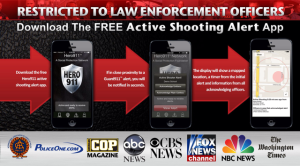How you & your cell phone can help combat active school shooters
In the last 18 months, nearly 26,000 LEOs across all 50 states have committed themselves and their smart phones to a unique effort in the fight against active-shooter attacks in schools. By the end of 2016, at least 100,000 sworn personnel from federal, state, county, and local agencies are expected to be part of this volunteer program. Spearheaded by veteran narcotics officer Nate McVicker, based in southern Illinois, the project is the outgrowth of brainstorming he and a “techie” civilian friend engaged in during an evening card game.
“I have three kids and I worry about attacks on schools,” McVicker told Force Science® News. “My friend and I were speculating on how to reduce the body count from active shootings, and we decided there must be a new way to use technology to get officers on the scene of an attack faster to neutralize the threat.”
The upshot, after more than a year of intense R&D, is an interactive cell phone system that allows a teacher or other school staff member to alert officers who may be on or off duty near the school at the same instant he or she calls 911 to report trouble. “This can save seconds or even minutes in getting an armed responder to the scene,” McVicker explains. “And as we know, even seconds saved can mean lives saved in an active shooting.”
The system has been recruiting police volunteer participants since August, 2014, and is rapidly gaining momentum. Here’s how it works: When a school registers as a protected property with a service company McVickers has formed (Guard911, LLC), each staff member at the school downloads a specially designed smart phone app called SchoolGuard. If a teacher, for example, hears or sees shooting or other evidence of a life-threatening problem, she touches a large “panic button” image on the app screen, which speed dials her through to a 911 call taker. Simultaneously, her touch sends a covert alarm signal throughout a “geo-fenced” area surrounding the school, covering a radius of five to 45 miles, depending on how isolated the site is. This signal is transmitted via GPS to all officers currently within that area, on or off duty, who have installed a “protective network” app called Hero911 on their cell phones.
This app, available free of charge through Google Play or the Apple store, provides receiving officers with the name and address of the school and a map of the property with a dot identifying the location at which the panic button was activated. When receipt is acknowledged, receiving officers are told how many other uniformed or plainclothes personnel in the area have confirmed notification.
“You may be out of your jurisdiction and just driving through an area on vacation,” McVicker says, “but if you’re a member of the nonprofit Hero911 network and you are near an active-shooter location, you’ll get the alarm and be able to respond if you choose, or at least have situational awareness. It’s easy to imagine an off-duty officer by chance being closer to the school and able to react faster than on-duty personnel.
“After all, out of more than 880,000 sworn personnel in the US, only about 20% are on duty, monitoring a radio at any given moment.” The network can multiply the potential response pool significantly, he explains. Citing the town of 10,000 where he lives as an example, he points out that only two municipal officers are on duty during a typical shift. Yet some 50 LEOs, from feds to locals, live in the area and others travel through it regularly. All those who happen to be within the protective radius when an emergency strikes could immediately be notified and show up to help through the Hero911 app.
When officers attempt to download the app and join the network, they are first vetted to confirm their law enforcement affiliation. And, in responding to an alarm when off duty or out of jurisdiction, they are expected to follow their individual departmental policies regarding such situations. Besides notifying nearby officers, the panic button alert also sends an alarm to all staff members on school property so they can initiate protective procedures in their areas.
Also, among other benefits, the school’s official active-shooter protocols will also appear on staff members’ cell phone screens for immediate guidance. Built into the technology are safeguards to prevent accidental false alarms. At present, about 120 schools in 13 states have signed up for the protection program, for which participating properties pay an initial set-up cost and nominal monthly maintenance fee. Besides elementary through high schools, similar systems are also available for businesses, churches, colleges, public buildings, shopping malls, event complexes, and other vulnerable locales through Guard911.
The program has been endorsed by prominent active-shooter response experts, including Lt. Col. Dave Grossman and active-killer researcher Ron Borsch. “We’re at war with active shooters, and attacks are increasing,” McVicker says. “We need to get the first one or two armed responders on scene a hell of a lot faster to make a difference. As the Hero911 network grows, I’m convinced that this phone app will be one critical way to reach that goal.”
For more information in video and print formats and for enrollment application, go to: www.Hero911.org and www.Guard911.com





